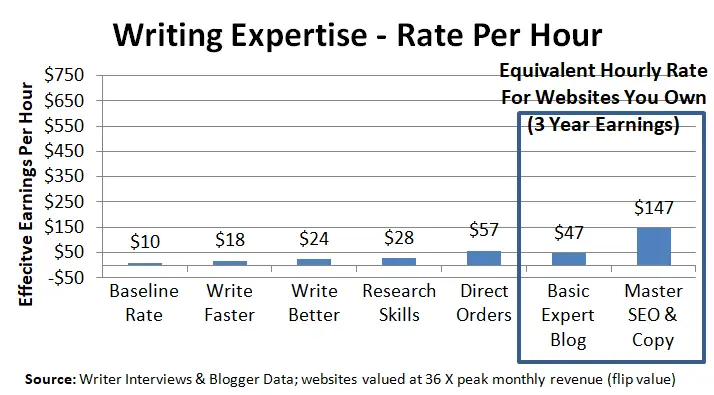
For today’s case study on how to earn a living wage in the gig economy, we’re going to show you to how squeeze high paid writing jobs out of an utterly reviled source.
Internet content mills.
Yes. Those dumps. The ones which pay by the word, averaging $5 and $10 per hour. We can level up to earn $50 per hour. With even more if you learn how to publish your own websites.
Why We’re Even Thinking About This…
Yes, this opportunity has a compensation model straight out of a Dickens Novel.
“Thank you sir, can I have another thousand words?”
And yet…. if you take a deep breath and look at the rest of the deal, this is the perfect remote job.
- You don’t need a local visa or work permit to earn money this way.
- There is no selling, clients are brought to you
- There is no collecting, the service makes clients pay first
- You can go for months without talking to another human.
- Working from 8 PM to 11 PM in your PJ’s as your kid sleeps in the other room.
This article is about using process and strategy to boost your earnings. Without losing all this wonderful flexibility. Because seriously, this is as good as it gets.
Our Strategy For Improvement
The Internet doesn’t run on computers. It runs on content: written words and cute cat videos. The typical content writer isn’t well paid but, in fairness, they aren’t efficient and their writing is horrible. We will show you how to fix both problems and build a high rate per hour business. With some upside if you use what you learn to build your own websites.
Let’s start with the pay. This is usually quoted as a cents per word number, dialed in at minimum wage. But top writers can make substantially more. Here is a roadmap on how to get there.

Improve As A Freelance Writer
- Get Faster
- Write Better
- Research Efficiently
- Go after Direct Orders
Build & Own The Website
- Basic Expert Blog
- Master SEO & Copy Writing
A quick note about cashflow… while most content mills pay writers immediately, building websites is a long term payback (18+ months). It takes about 12 – 18 months for Google to recognize the quality of your work and start sending you real traffic. Once you get an audience, it becomes a platform for generating passive income via advertising and affiliate marketing. A well written article can earn money for years.
There is a natural synergy between freelance writing and launching a digital publisher. The experience you get as a writer will help teach you how to create content efficiently. Furthermore, you can use the writing assignments to jump-start your research on a topic, accelerating the writing process for your own website. You can earn two or three times more per hour invested writing for your own website, if you’re willing to wait a while for the content to rank up on Google.
Want to earn even more? Read up on the basics of digital marketing. The numbers above, based on examples from actual websites, show the impact of basic search engine optimization and copy writing. The first project was from running ads on an “industry expert blog” created by someone who wasn’t deep into SEO and copy writing. The second was “optimized” to rank higher on Google, deliver a better user experience, and promote a relevant merchant. As you can see, earnings per hour invested tripled when the website was marketed effectively.
Step 1: Improve Speed and Quality
When one of our contributing writers first started on TextBroker, she was lucky if she could make $10 per hour. Her writing was slow, and she was not a highly ranked writer on their platform. Most jobs she wrote only paid a few dollars. One of the best ways to increase speed is through practice. It doesn’t take as long as you might think, a month of daily writing can double your writing speed. This improvement in her writing speed turned her initial $10 an hour effective rate into $18 an hour – still not where we need to be, but some positive progress… and ahead of unemployment in most states.

You may be tempted to split your work across a couple of different sites. This is actually far less helpful than you might think. TextBroker and most freelancing sites have some form of advancement system. Writers are assigned different levels. Each level advancement brings a pay raise as well as access to additional jobs. In these cases, it doesn’t make sense to constantly switch between platforms, as it will make it much harder to advance. Instead, choose one platform. Work your way up to higher levels. Then, if you choose, work your way up on a second platform.
Which brings us to the topic of how to move up. This works differently on all content mills, although on Textbroker it is decided by editors. The usual barrier to advancement is grammar and writing quality. Textbroker requires that all articles be written in AP style. Many authors are unaware of this, so they fail every editing check. Check your platform’s conditions for advancement – and manage to them! Otherwise you will have highly satisfied clients yet fail to advance (and raise your rates).
Incidentally, you don’t have to do this the hard way. There are programs which can automatically check your grammar against the AP style guide. This will increase your productivity and increase your odds of moving up to a higher paying tier on the platform.
Moving up to the next level will earn you a higher rate per word, in this case increasing our source’s effective hourly rate (at 4 stars) up to $24 to $30. While this is great progress (and starts to resemble a living wage), we’re only halfway to goal. Onwards!
There is one good exception to focusing your efforts on one writing platform: if you want to address two radically different groups of buyers. Especially if there is a big difference in prices. For example, an industry expert might position their Upwork profile at a very high rate, between $100 – $250 per hour. While they probably won’t fill their calendar there, the business they close will be at very high prices. Meanwhile, they can use TextBroker open orders (or their own websites!) as as dumping ground for any unsold time, offering their services at a bargain price…. as long as the client is flexible about due dates.
Step 2: Research Efficiently

Let’s talk about research for a moment, since that can be a serious drag on your productivity. You’re going to need to know enough about a topic to crank out a credible article. This inevitably forces you to spend some time with Google learning the finer points of whatever particular topic hits your Inbox. Getting efficient at research is a huge way to earn more per hour.
I’ll start with the obvious one. Write about what you know. Most content mills will break topics into categories. If you like food, consider writing articles in the food and beverage category. This significantly reduces your research time and helps keep you excited about what you are writing. One of the easiest ways to write more, and therefore make more, is to pick topics that you are excited about. Unfortunately, you may not always be excited about the topics available, especially on lower levels. Don’t worry, it gets better.
If you really want to squeeze the time out of your research process, try “tripling up”. Oftentimes, clients will post batch orders, which are several of the same assignment. Usually, writers can complete up to three of these orders themselves. This means you can do the same batch of initial research and crank out three articles on the topic.

For even greater research efficiency, look for batch orders that are slightly different, but from the same client and about the same topic. If you can find these, you can potentially write six orders from the same initial research.
Mastering how to do research efficiently is a big productivity booster, at least a 20% bump in total output as a freelance writer. That being said, you’re constrained since you can’t usually choose the topic.
UNLESS YOU ARE WORKING ON YOUR OWN WEBSITE…. which obliterates that constraint. I can write whatever I want, as much as I want, under whatever title and topic descriptions I choose. We recycle research & material shamelessly around here, often across websites and into different content formats. For a specific example, here’s what a 5 hour survey several years ago turned into:

- A table-thumping 3000 word dissertation
- An “executive summary”
- A blog post (most popular version)
- A web calculator
- 5 “How To” guides
- 15 pages about specific niches
- Three short “strategy articles”
- A “follow-up” study two years later
- A “retrospective” op-ed piece seven years later
- At least three articles on other websites
- A few dozen blog comments & tweets
This earned us the leading slot in Google for that particular niche – which we kept for about 6 years. Seriously. It’s some of the best content I’ve ever produced. And look, we just cited it again!
Don’t do anything stupid or unethical, of course, like copy a client’s idea or publish the article on your blog. But if you’ve spent time researching Egyptian hummingbirds today for a client, why not crank out a few unrelated bonus pieces for your own site while you’ve got all that free research in your head?
Step 3: Pursue Direct Orders

One of the benefits of working for a content mill is that you don’t need to solicit your own clients. For those who hate cold calling, like me, this is a huge bonus. Doing this within a mill is different but can still be intimidating. After writing several jobs, you may notice that you are getting rated by the clients that you write for. Not all clients fill out the rating page but many do. While this is often a source of helpful feedback, it opens the door to higher paying writing jobs.
After getting a rating, message the client. If the rating was good or better, tell them that you loved writing their order because the topic is something that excites you or is fun. Don’t lie about this. If the rating is poor, message the client and ask if they want the content rewritten. Both strategies build a rapport with clients. (Obviously, if the topic is boring or dull, discretion often is the better part of valor… stay silent and look for something more appealing.)
Standing out from other writers is important on a content mill. After a rapport is developed, at least on Textbroker, clients will either directly order from you, or invite you to a team. Teams are topic-focused groups that have their own order pool. Direct orders, as the name implies, are when clients as for work from you directly. The pay for these is at least double what you earn at most levels. Combined with the earlier improvements, this may push you over the $50 an hour mark.

That’ll be 20 cents a word…
I’ve got an additional tip for professionals with deep technical knowledge or industry expertise. Flaunt it on your profile and increase your direct order rates once you start getting some traction. Especially if you know a lot about an obscure topic or have an advanced professional degree. Speaking as a publisher, I would much rather have someone with industry experience developing my content and am very willing to pay more. This includes legal, medical, engineering, and computer programming. There is niche content only you can write and you may as well get paid something extra for it! The same goes for senior business executive with deep expertise in a specific industry or operating discipline. Experts wanted, apply within. This is a great way to become one of the top paid freelance writers within a content mill.
If you make it to this level, you likely have “leveled up” your writing and research skills to the point where you can pursue more advanced assignments. This could include going on staff as a blog writer or regular columnist. It could also include pursuing more advanced projects on another freelancing site. I’ve enclosed some links at the end for you to take a look at. Be sure to bookmark this page for future updates.
Step 4: Feed Your Own Website
Finally, all of this is a great way to kick start your own blog or a content website. You’re getting paid to learn how to write faster (and better), not to mention research a wide range of topics in a couple of chosen niches. When you’re done doing the writing assignment, think about how you can recycle some of these ideas into your own website content.

You can triple your typical earnings as a blogger if you master the basics of several additional skills. Read up on basic SEO and social media marketing. Most blogs are poorly marketed: a little effort in this area can pay off with a big boost in traffic. On a similar note, invest time in learning the basics of advertising copy-writing. This can be applied to both engage an audience and promote special offers. You might even find a new career (good copy writers are worth their weight in gold). Finally, I recommend any blogger learn the basics of setting up WordPress and Google Analytics (tracking tool).
A word of caution: building a website is a long term strategy. It will take several months (at best) for an article to start ranking in Google. Furthermore, most of your traffic will come from a tiny share of your articles, so the entire process is very hit and miss. Be ready to write a lot of articles (100 – 200) across multiple topics to raise your odds of finding a big winner. Allocate at least 250 hours in your first year.
If all you want to do is write and collect cash right now, you’re better off working for the content mill. Your initial earnings as a blogger will be significantly lower, since you are still learning the process (how to promote your work) and building up momentum. This picks up quickly, as you learn how to write effectively (SEO & copywriting), and your website acquires authority.
However, there are some nice synergies between publishing on your own blog and working as a freelance writer. It provides great protection against a flaky client (for a writer or consultant). Someone bail on their appointment or cancel the job, leaving an unpaid hole in your calender? Go write some blog content. This converts a permanent loss of paid work into an opportunity to build future passive income. And as I mentioned before, you can easily recycle the research you do for content mill articles into multiple additional pieces of content for your own websites. Stay ethical and legal of course: don’t repost client content on your own website or steal their ideas.
Mission Accomplished: Going From $10 to Over $50 Per Hour
Is this for everyone?
No. The starting point of the journey sucks. While working conditions are pretty good (for a professional job that tolerates weird hours, strange locations, and minimal human contact), the initial pay is garbage.
However, the end game is pretty solid. You can use content mills to jump-start a writing career and develop the skills you need to increase your earnings per hour. Content mills can spell the difference between being a working writer (generating cash, published samples, and relationships) and “aspiring writer” who spends most of their time on the couch. They also work great as a dumping ground for unsold time. The biggest payoff is if you end up launching your own websites or cross over into the self-publishing space like creating a high end coaching program or skillshare courses.
Want to know more? Check out our list of the best content mills for new writers.
We’ve got some additional resources explaining the market for writers in India.
Links For High Paying Freelance Writing Jobs
- TextBroker – Recommended Starting Point
- Who Pays Writers – CrowdSourced List With Rates
- ProBlogger Job Board – Longer Term Gigs
- Media Bistro – Writing Job Board
- Guru.com – Another Gig Job Board
- Upwork – Another Gig Job Board
- A List Apart – Writing Agency, High End
- SitePoint – Technical Tutorials, Higher Rates
- ListVerse – Top 10 Lists
- LWN.Net – Technical content on open source, pays well
- SQL Server Central – Technical content on SQL
Got another source of High Paying Freelance Writing Jobs? Drop us a line…
Editorial Team: Many thanks to our five anonymous contributors who shared their experiences as content mill writers. They practice what they preach and are both traveling the world while doing High Paying Freelance Writing Jobs to support themselves.